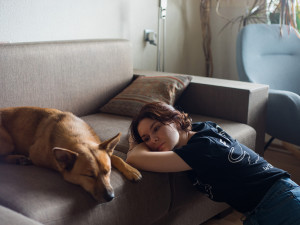Animal Shelters Are in “Crisis” Due to the Rising Cost of Living
Overcrowding is at an all-time high.
Even one pet waiting for a forever home is one pet too many — but the bleak reality is that shelters are often overrun with potential adoptees. The pandemic resulted in record adoptionsopens in new tab, but those numbers quickly dwindled as inflation soared and people got back to in-person work. And now, a few years out from that brief surge, the crisis is worse than ever. Inflation and the rising cost of living are causing pets to be surrendered in droves — and preventing potential adopters from stepping up to rescue them.
Shelters are filling up.
According to Shelter Animals Countopens in new tab, a national database that surveys nearly 7,000 animal organizations annually, the number of dogs taken in by shelters is up 22 percent since 2021. At the end of 2023, there were 250,000 more animals in shelters than at the beginning of the year. Stephanie Filer, executive director of Shelter Animals Count, says shelters are seeing an increaseopens in new tab in puppies and purebred dogs, who typically have fewer issues finding forever homes.
Animal Care Centers (ACC) of NYC, the largest animal shelter in New York City, is one of many shelters experiencing major overcrowding — last year, their numbers were up 41 percent. In October, ACC’s resources were so overwhelmed that they had to close their doorsopens in new tab to new surrenders. “Shelters are quite literally at crisis, and some of them are making the decision to close their doors or reduce hours of operation or reduce the kind of animals that they bring in,” Filer told TIME magazineopens in new tab.
Why are shelters so crowded?
A person may surrender a pet or feel discouraged from adopting one for many reasons, but one overarching issue sticks out above the rest: money. “Animal shelters generally reflect what is happening to people in a community and where there is food insecurity,” Filer told CBS.
How much do you spend on your pet per year?
Inflation rates have soared in recent years, impacting the costs of everything from vet care to pet food. “Dog food costs have surpassed the consumer price index,” Katy Hansen, director of marketing and communications for ACC of NYC, told Kinship in 2022. Her colleague, Zoe Kenney, seconded this, telling TIME, “Sometimes people are choosing between putting food on their plate and putting food on their pet’s plate.”
A lack of pet-friendly housing is another factor keeping people from adopting pets — or, in tragic cases, forcing renters to surrender their companions. Though the percentage of pet-friendly buildings is increasing each year, according to Brick Undergroundopens in new tab, only 63 percent of buildings were pet-friendly in 2023. Allia Mohamed, co-founder and CEO of Openiglooopens in new tab, told the publication that pet-friendly buildings are also 30 to 40 percent more expensive on average.
“Landlords in New York City pretty much have the upper hand,” Hansen told CBS. “We're getting pets that have been in the family for years and years.”
Breed specific restrictions are another factor inhibiting the housing choices of pet parents. These policies specifically prohibit certain breeds — typically, Pit Bulls and Pit Bull-type dogs — from living in buildings.
How can you help?
If you want to help, volunteering at a shelter or donating to a pet charity can make a huge difference in a pet’s — and a pet parent’s — life. Fostering pets is a direct way to alleviate a shelter’s resources. And, of course, if you’re able and looking to adopt a new family member, now’s the perfect time.
If you and your pet need help with vet bills or food costs, there are many organizations dedicated to serving pets in need. Check out our guide to finding free pet food near you and our list of nine organizations that can help you pay your vet bills.











